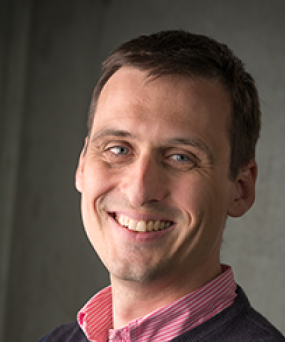- Homepage
- Programme
- Registration
- Practical Guide
- About Neuronus

NERF, Belgium

Sebastian Haesler is a professor of Neuroscience at the Katholieke Universiteit Leuven and Director of Neuroelectronics Research Flanders (NERF). He received his Ph.D. degree from the Max-Planck-Institute for Molecular Genetics, Berlin, Germany, in 2006. Next, he did his post-doctoral work with the Center for Brain Science, Harvard University, Cambridge, MA, USA, with support from the Human Frontiers Science Program. Since 2013, prof. Haesler occupies his current position at KU Leuven, and directs NERF since 2015.
In his work he studies the brain by mechanistically dissecting fundamental information processing problems using mice as model animals. In particular, the Haesler Lab focuses on analyzing the ability to discriminate novel from familiar sensory stimuli. Additionally, the team develops novel brain interfaces to undertake current problems and limitations in manipulating the brain and effectively measuring its activity. These technologies are aimed to be designed in a way to find clinical and research applications.
Publication topics include the study of neural circuts underlying exploration and curiosity, and the design of the synaptrode-a device where electrodes make synapse-like connections with selected subpopulations of neurons enabled by the molecular code of cell adhesion molecules. Overall, techniques most commonly used by the team range from magnetic resonance imaging (MRI), through neurophysiological recordings, to brain-computer intefaces, providing an interdisciplinary approach to current neuroscience issues.
Curiosity refers to the intrinsic desire of humans and animals to explore the unknown even when there is no apparent reason to do so. The most fundamental form of curiosity may be found among orienting behaviors. Across animal species, novel or surprising stimuli elicit arousal and evoke sensory inspection and exploration. These orienting responses habituate after few exposures, suggesting a very rapid form of non-associative learning. At the level of neural circuits, orienting involves distinct processing steps including the evaluation of sensory stimuli to detect novelty and surprise, the activation of catecholaminergic systems and eventually the initiation of orienting reactions. In my lab, we investigate these processing steps using brain-wide functional ultrasound imaging, large-scale electrophysiology and cell-type specific manipulations in mice in order to understand how neural circuits transform sensory inputs into curious exploration behaviors.
Neuropixels 2.0: A miniaturized high-density probe for stable, long-term brain recordings. Steinmetz NA, Aydin C, Lebedeva A, Okun M, Pachitariu M, Bauza M, Beau M, Bhagat J, Böhm C, Broux M, Chen S, Colonell J, Gardner RJ, Karsh B, Kloosterman F, Kostadinov D, Mora-Lopez C, O'Callaghan J, Park J, Putzeys J, Sauerbrei B, van Daal RJJ, Vollan AZ, Wang S, Welkenhuysen M, Ye Z, Dudman JT, Dutta B, Hantman AW, Harris KD, Lee AK, Moser EI, O'Keefe J, Renart A, Svoboda K, Häusser M, Haesler S, Carandini M, Harris TD. Science. 2021 Apr 16;372(6539):eabf4588. doi: 10.1126/science.abf4588.
Implantation of Neuropixels probes for chronic recording of neuronal activity in freely behaving mice and rats. van Daal RJJ, Aydin Ç, Michon F, Aarts AAA, Kraft M, Kloosterman F, Haesler S. Nat Protoc. 2021 Jul;16(7):3322-3347. doi: 10.1038/s41596-021-00539-9. Epub 2021 Jun 9.
Cue-Evoked Dopamine Promotes Conditioned Responding during Learning. Morrens J, Aydin Ç, Janse van Rensburg A, Esquivelzeta Rabell J, Haesler S. Neuron. 2020 Apr 8;106(1):142-153.e7. doi: 10.1016/j.neuron.2020.01.012. Epub 2020 Feb 5.
Multiplexed Surface Electrode Arrays Based on Metal Oxide Thin-Film Electronics for High-Resolution Cortical Mapping. Londoño-Ramírez H, Huang X, Cools J, Chrzanowska A, Brunner C, Ballini M, Hoffman L, Steudel S, Rolin C, Mora Lopez C, Genoe J, Haesler S.Adv Sci (Weinh). 2024 Mar;11(10):e2308507. doi: 10.1002/advs.202308507. Epub 2023 Dec 25.
Curiosity-driven exploration: foundations in neuroscience and computational modeling. Modirshanechi A, Kondrakiewicz K, Gerstner W, Haesler S. Trends Neurosci. 2023 Dec;46(12):1054-1066. doi: 10.1016/j.tins.2023.10.002. Epub 2023 Nov 2.